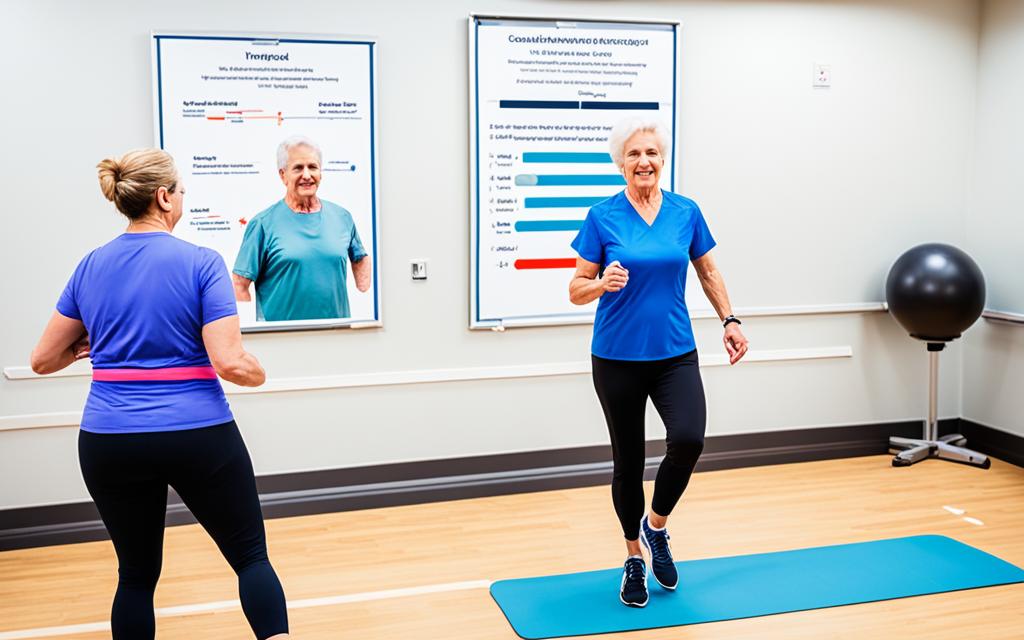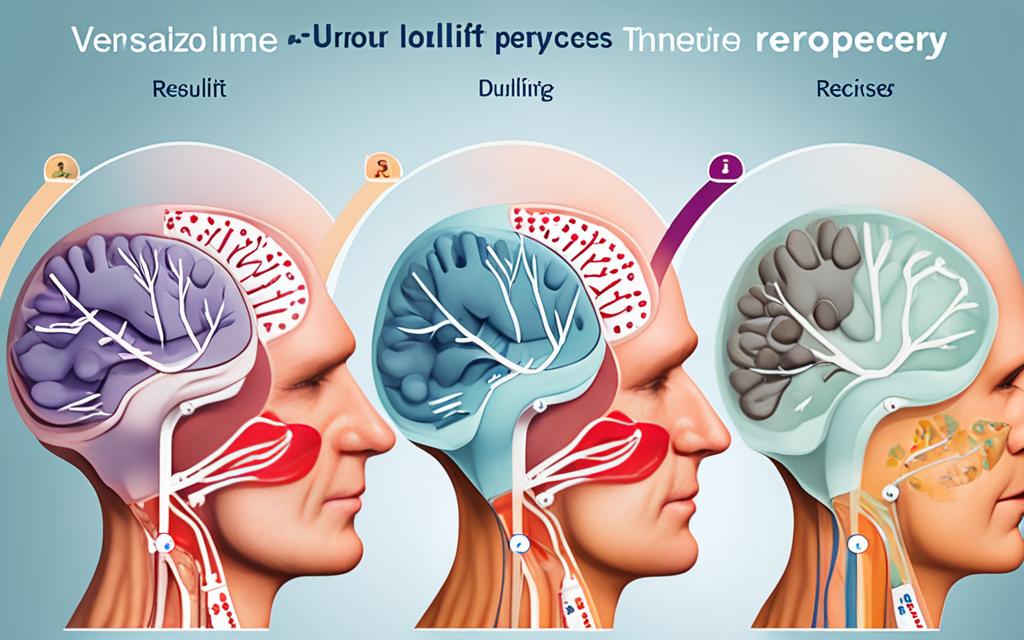Welcome to our comprehensive guide on the uroLift recovery timeline and exercise guidelines. If you have recently undergone the UroLift procedure, it’s important to understand the recovery process and how exercise can play a role in your post-procedure journey. In this section, we will provide you with all the information you need to navigate through the recovery period, ensuring a smooth and successful healing process.
Before we delve into the specifics of the recovery timeline, it’s essential to have a clear understanding of the UroLift procedure itself. This innovative treatment is designed to help individuals suffering from benign prostatic hyperplasia (BPH). By providing relief from BPH symptoms, such as frequent urination and weak urine flow, the UroLift procedure offers a long-lasting solution for patients seeking improved quality of life.
Immediately after the UroLift procedure, it’s crucial to follow the post-procedure care instructions provided by your healthcare professional. These instructions will aid in promoting healing and reducing any potential discomfort during the initial recovery phase.
Every individual’s recovery timeline may vary, but in general, you can expect a progressive improvement in your condition over time. From the initial days to weeks and months following the UroLift procedure, we will guide you through the different stages of recovery and offer insights into what you can anticipate.
Resuming physical activities, including exercise, is an important aspect of maintaining overall health. However, it’s crucial to prioritize your recovery and gradually reintroduce physical activity into your routine. We will provide recommendations on when it’s safe to resume exercise and how to do so without jeopardizing your healing progress.
During the UroLift recovery period, we understand the importance of staying active and maintaining fitness. We will present exercise guidelines that are safe to follow, ensuring that you can engage in physical activity without hindering your recovery process.
As you progress through the recovery timeline, you can gradually increase the intensity of your exercise routine. We will guide you on how to do so in a safe and controlled manner, allowing your body to adapt and strengthen as you continue your healing journey.
While staying active is beneficial, it’s equally important to understand any exercise restrictions that may be necessary to ensure a smooth recovery. We will outline any potential limitations and precautions that you should be aware of, enabling you to make informed decisions regarding your exercise regimen.
Lastly, we will highlight the numerous benefits of incorporating exercise into your UroLift recovery routine. From improving overall well-being to aiding in the healing process, exercise can be a valuable tool in your journey towards optimal health.
Remember, every individual’s recovery experience may differ, and it’s essential to consult your healthcare provider for personalized guidance based on your specific condition and progress. By following the exercise guidelines and recovery timeline, you can promote a successful UroLift recovery and regain your normal routine with confidence.
Key Takeaways:
- Understanding the UroLift procedure is crucial before diving into the recovery timeline.
- Follow immediate post-procedure care instructions to promote healing and minimize discomfort.
- The UroLift recovery timeline can vary, but gradual improvement is expected over time.
- Consult with your healthcare provider to determine when it’s safe to resume physical activities, including exercise.
- Follow exercise guidelines during the UroLift recovery period to ensure a smooth healing process.
Understanding the UroLift Procedure
Before diving into the recovery timeline, it’s important to understand the UroLift procedure itself. The UroLift procedure is a minimally invasive treatment option for patients with benign prostatic hyperplasia (BPH). It offers a new approach to address the symptoms of BPH without the need for traditional surgery or ongoing medication.
During the UroLift procedure, small implants are placed in the prostate to lift and hold the enlarged tissue away from the urethra. This helps to relieve the pressure on the urethra and improves urine flow. The entire procedure is performed through the natural pathway, eliminating the need for any incisions or removal of prostate tissue.
“The UroLift procedure is an innovative and effective solution for patients suffering from the symptoms of BPH. It provides long-term relief with minimal downtime and preserves sexual function, making it an attractive option for many individuals.”
One of the key benefits of the UroLift procedure is its quick recovery time. Unlike traditional surgeries, patients typically experience minimal discomfort and can return to their normal activities within a few days. It also offers excellent long-term results, with studies showing improvement in symptoms and quality of life up to five years after the procedure.
This revolutionary procedure has transformed the lives of many individuals who were struggling with the bothersome symptoms of BPH. By understanding the UroLift procedure and its benefits, you can make an informed decision about whether it is the right treatment option for you.
To visualize the UroLift procedure, here is an informative diagram:
Immediate Post-Procedure Care
After undergoing the UroLift procedure, it is essential to follow specific post-procedure care instructions to promote healing and minimize any discomfort. By adhering to these guidelines, you can ensure a smooth recovery process.
Here are some immediate care instructions and restrictions to keep in mind:
- Take it easy: Rest is crucial during the initial days following the procedure. Avoid any strenuous activities and give your body the time it needs to heal.
- Pain management: Your healthcare provider may prescribe pain medications to alleviate any post-procedure discomfort. Follow their instructions and take the medication as recommended.
- Avoid heavy lifting: To prevent strain on the treated area, refrain from lifting heavy objects for a specified period. Your healthcare provider will provide guidance on when you can resume this activity.
- Drink plenty of fluids: Staying hydrated is essential after any medical procedure. Aim to drink an adequate amount of water throughout the day to support the healing process.
- Follow dietary restrictions: Your healthcare provider may advise you to follow specific dietary guidelines during the immediate post-procedure period. It’s important to adhere to these restrictions to aid in recovery.
- Keep the treated area clean: Proper hygiene is crucial during the recovery phase. Follow any instructions given by your healthcare provider regarding wound care and cleansing the treated area.
“Post-procedure care plays a significant role in the success of your UroLift recovery. By following the immediate care instructions provided by your healthcare provider, you can optimize the healing process and ensure the best possible outcome.”
By prioritizing your post-procedure care, you can enhance your recovery experience and get back to your daily routine in a prompt and healthy manner.
UroLift Recovery Timeline
The recovery timeline after the UroLift procedure can vary from person to person. It’s important to understand the stages of post-UroLift recovery to know what to expect and how to manage your healing process. Here is a general timeline of the recovery journey:
Days 1-7: Immediate Recovery
During the first week, you may experience some mild discomfort, urinary frequency, or urgency. This is normal as your body adjusts to the UroLift implants. It’s recommended to take it easy and avoid strenuous activities.
Weeks 2-4: Early Recovery
As you progress into the second and third week, you should start feeling significant improvement. Most patients find relief from their BPH symptoms, and any discomfort gradually subsides. However, it’s still important to follow the post-UroLift recovery guidelines provided by your healthcare provider.
Months 1-3: Continued Healing
During the first three months, your body continues to heal and adjust to the UroLift procedure. You may notice further improvement in your urinary symptoms, leading to a better quality of life. It’s essential to attend all follow-up appointments and communicate any concerns to your healthcare provider.
Remember, every person’s recovery is unique, so it’s important to consult with your healthcare provider for personalized guidance based on your specific progress.
Following a healthy lifestyle, including a balanced diet and regular exercise, can also contribute to a faster UroLift recovery. It’s crucial to prioritize self-care and listen to your body throughout the healing process.
When to Resume Physical Activities
Physical activities, including exercise, play a crucial role in maintaining overall health. However, after undergoing the UroLift procedure, it’s important to give your body enough time to heal before engaging in strenuous activities. Resuming physical activities too soon can potentially hinder your recovery and lead to complications.
It is recommended to consult with your healthcare provider for personalized guidance on when it is safe to resume physical activities. The timeline for resuming physical activities may vary based on individual factors, such as the extent of the UroLift procedure and your overall health condition.
Typically, most patients can begin low-impact activities, such as light walking, within a few days after the procedure. However, it’s crucial to listen to your body and avoid pushing yourself too hard too soon.
“It’s important to give your body enough time to heal before engaging in strenuous activities.”
| Physical Activity | Timeline |
|---|---|
| Light Walking | Within a few days after the procedure |
| Low-Impact Exercises | After about a week or as advised by your healthcare provider |
| Gradual Increase in Intensity | Follow your healthcare provider’s guidance, typically after a few weeks |
| Strenuous Activities | After several weeks to a few months, depending on your individual recovery progress |
Remember, it is essential to prioritize your recovery and follow your healthcare provider’s recommendations when resuming physical activities. Gradually introducing exercise into your routine can help prevent any complications and ensure a smooth recovery.
Next, we will discuss the exercise guidelines during UroLift recovery, providing you with valuable recommendations to safely incorporate exercise into your post-procedure routine.

Exercise Guidelines during UroLift Recovery
While physical activity is beneficial for overall health, it is crucial to approach exercise with caution during the UroLift recovery period. Following proper exercise guidelines can help promote healing and prevent any complications. Here are some recommendations and guidelines to ensure a safe and effective exercise routine during your UroLift recovery:
- Consult with your healthcare provider: Before engaging in any exercise routine, it’s essential to consult with your healthcare provider. They can provide personalized advice based on your specific condition and recovery progress.
- Start slow and gradually increase: Begin your exercise routine with low-impact activities such as walking or gentle stretching. Gradually increase the intensity and duration of your workouts as you feel comfortable and experience minimal discomfort.
- Avoid heavy lifting: During the initial stages of UroLift recovery, it is advisable to avoid heavy lifting or straining activities. This can help prevent strain or pressure on the surgical site and promote healing.
- Listen to your body: Pay attention to any pain, discomfort, or fatigue during your exercise routine. If you experience any unusual symptoms, it’s important to stop and rest. Pushing yourself too hard can delay the healing process.
- Include pelvic floor exercises: Engaging in pelvic floor exercises can be beneficial for improving urinary control and strengthening the muscles in the area. Consult with a physical therapist or healthcare provider for guidance on specific exercises.
Remember, every individual’s recovery timeline may vary, so it’s important to listen to your body and follow the guidance of your healthcare provider. Here’s an image to help you visualize some safe exercises during your UroLift recovery:
By following these exercise guidelines and recommendations, you can support your UroLift recovery and gradually regain your normal exercise routine. However, always prioritize your health and consult your healthcare provider when in doubt.
Gradually Increasing Exercise Intensity
As you progress through the UroLift recovery timeline, it’s important to gradually increase the intensity of your exercise routine. This will allow your body to adapt and build strength without putting unnecessary strain on your healing prostate. By following these guidelines, you can safely increase exercise intensity and continue on your path to a full recovery.
Start with Low-Impact Exercises
During the initial stages of your UroLift recovery, it’s recommended to begin with low-impact exercises that are gentle on your body. Walking, swimming, and cycling are excellent options to get your body moving without causing discomfort or excessive strain. These activities help improve circulation, maintain muscle tone, and promote overall well-being.
It’s important to listen to your body and pay attention to any discomfort or pain during your workout sessions. If you experience any discomfort, it’s advisable to scale back and modify your activities accordingly. Always consult with your healthcare provider before starting any new exercise program.
Progress Gradually
Once you have established a routine with low-impact exercises, you can gradually increase the duration and intensity of your workouts. For example, if you are walking for 30 minutes a day, try adding an extra 5 minutes every week. Similarly, if you’re cycling, increase the resistance or incline gradually over time.
Remember, the key is gradual progression. Pushing yourself too hard too soon can hinder your recovery and potentially lead to complications. Be patient with your body and give it ample time to rebuild strength and endurance.
Incorporate Strength Training
Strength training exercises can be gradually incorporated into your routine as you progress in your recovery. These exercises help build muscle, improve bone health, and support overall functional fitness. Start with light weights and gradually increase the resistance as your body adjusts.
Focus on compound exercises that target multiple muscle groups such as squats, lunges, push-ups, and rows. Incorporating resistance bands and bodyweight exercises can also be effective in building strength without straining your body. Remember to maintain proper form and technique to avoid any unnecessary stress on your joints and muscles.
Listen to Your Body
Throughout your UroLift recovery, it’s crucial to listen to your body and respond to any signs or symptoms of overexertion. If you experience increased pain, swelling, or discomfort during or after exercise, it’s important to scale back and consult with your healthcare provider.
Always prioritize your safety and well-being. Gradually increasing exercise intensity should be done in a controlled and mindful manner, ensuring that you are not pushing yourself beyond your limits. Your body knows best, and it’s important to respect its needs during the recovery process.

| Exercise Intensity Level | Recommendations |
|---|---|
| Low Intensity | Start with gentle activities such as walking, swimming, and cycling. Monitor your body’s response to exercise and gradually increase the duration. |
| Moderate Intensity | Incorporate moderate-intensity exercises like jogging, aerobics, or using an elliptical machine. Increase intensity gradually by adjusting speed or resistance. |
| High Intensity | Advance to high-intensity exercises such as running, interval training, or participating in group fitness classes. Increase intensity incrementally while maintaining good form and technique. |
Remember, always consult with your healthcare provider before making any significant changes to your exercise routine. They can provide personalized guidance based on your specific condition and recovery progress. By gradually increasing exercise intensity after UroLift, you can safely and effectively regain your strength and vitality.
Exercise Restrictions to Watch for
While it’s important to stay active and maintain a healthy lifestyle, it’s crucial to be aware of exercise restrictions following the UroLift procedure. These restrictions are necessary to ensure a smooth recovery and avoid any complications. Here are some exercise restrictions and precautions to keep in mind:
1. Avoid Strenuous Activities
During the initial stages of recovery, it’s essential to avoid any activities that put excessive strain on your body. This includes heavy lifting, intense workouts, and high-impact exercises. These activities can cause discomfort and hinder the healing process. Instead, focus on gentle movements and light activities that help maintain mobility without exerting excessive pressure on the treated area.
2. Stay Away from Activities that May Cause Injury
Engaging in activities that carry a higher risk of injury is not recommended during the early stages of recovery. This includes contact sports, extreme sports, and activities with sudden and forceful movements. The UroLift procedure requires time for the treated area to heal properly, and avoiding such activities can reduce the risk of complications and ensure a successful recovery.
3. Follow your Healthcare Provider’s Guidance
Each individual’s recovery process may be unique, and it’s essential to follow your healthcare provider’s specific instructions regarding exercise restrictions. They will provide personalized guidelines based on your condition and recovery progress. Consult with your provider to understand the timeframes and limitations that apply to your situation.
Remember, taking the necessary precautions and adhering to exercise restrictions during the UroLift recovery period is vital for a successful outcome. It’s important to prioritize your well-being and follow the advice of your healthcare provider to ensure a smooth and speedy recovery.
Benefits of Exercise in UroLift Recovery
Exercise plays a vital role in our overall health and well-being, and this holds true even during the UroLift recovery period. Incorporating physical activity into your recovery routine can have numerous benefits and aid in the healing process.
Regular exercise can help improve blood circulation, boost your immune system, and enhance mood and mental well-being. It can also help prevent muscle loss, maintain joint flexibility, and manage weight. These benefits are particularly important during the recovery period after undergoing the UroLift procedure.
Engaging in light to moderate exercise can help minimize post-procedure discomfort and promote faster healing. Physical activity stimulates blood flow, which in turn delivers oxygen and nutrients to the healing tissues. This can speed up the recovery process and enhance overall tissue health.
In addition, exercise can help reduce the risk of complications such as blood clots and infections by improving circulation and strengthening the immune system. It can also help alleviate stress and anxiety, which are common during the recovery period.
Choosing the Right Exercises
During the UroLift recovery period, it’s essential to choose exercises that are low impact and gentle on the body. Avoid strenuous activities that may put excessive strain on the pelvic area.
Some recommended exercises during UroLift recovery include:
- Walking: Walking is a low impact exercise that promotes blood flow, cardiovascular health, and overall well-being.
- Stretching: Gentle stretching exercises can help maintain joint flexibility and reduce muscle tension.
- Yoga: Yoga combines stretching, flexibility, and mindful movements, making it an excellent choice for maintaining physical and mental well-being during the recovery period.
Consulting with Your Healthcare Provider
It’s important to consult with your healthcare provider before starting any exercise routine during the UroLift recovery period. They can provide personalized guidance based on your specific condition and recovery progress. They may also recommend specific exercises or modifications tailored to your needs.
| Exercise Benefits in UroLift Recovery |
|---|
| Promotes blood circulation and oxygen delivery to healing tissues |
| Boosts the immune system and reduces the risk of complications |
| Helps maintain joint flexibility and prevent muscle loss |
| Aids in managing weight and overall well-being |
| Reduces stress and anxiety during the recovery period |
Incorporating exercise into your UroLift recovery routine can have significant advantages for your overall health and aid in the healing process. However, always remember to listen to your body and gradually increase exercise intensity as you progress through the recovery timeline.
Consult with your healthcare provider for personalized guidance and exercise recommendations to ensure a safe and effective recovery.
Conclusion
After undergoing the UroLift procedure, the recovery timeline can vary from person to person. To ensure a smooth recovery, it is crucial to follow the exercise guidelines provided. By gradually introducing exercise and adhering to any restrictions, you can support your healing process and regain your normal routine.
Consulting with your healthcare provider is essential for personalized guidance based on your specific condition and recovery progress. They can provide valuable insights and recommendations tailored to your needs. Remember, everyone’s journey is unique, so it’s important to stay patient and allow your body the necessary time to heal.
Investing in your recovery by following the exercise guidelines not only aids in the healing process but also promotes overall well-being. Physical activity has numerous benefits, including boosting mood, improving cardiovascular health, and enhancing strength and flexibility. By incorporating exercise into your recovery routine, you can experience these advantages and expedite your return to an active lifestyle.
Always prioritize your health and follow the exercise guidelines during the UroLift recovery period. With time, patience, and adherence to the provided recommendations, you can navigate the recovery process with confidence and successfully resume your favorite activities with a renewed sense of well-being.
FAQ
How long after the UroLift procedure can I start exercising?
It is recommended to wait for at least one week after the UroLift procedure before starting any exercise activities. However, this may vary depending on your individual recovery progress. It is best to consult with your healthcare provider for personalized guidance.
What activities can I engage in during the UroLift recovery period?
During the UroLift recovery period, you can engage in light activities such as walking and gentle stretching. It is important to avoid activities that involve heavy lifting, straining, or vigorous exercise until you are cleared by your healthcare provider.
Can I resume intense workouts after the UroLift procedure?
It is important to gradually increase exercise intensity after the UroLift procedure. Once you have fully recovered, your healthcare provider may give you the green light to resume intense workouts. However, it’s always best to consult with your healthcare provider for personalized guidance based on your individual recovery progress.
Are there any exercise restrictions following the UroLift procedure?
While it is important to stay active, there may be certain exercise restrictions following the UroLift procedure. These restrictions may include avoiding heavy lifting, strenuous exercises, or activities that put pressure on the pelvic area. It is crucial to follow your healthcare provider’s recommendations and gradually reintroduce exercise as you progress through your recovery.




